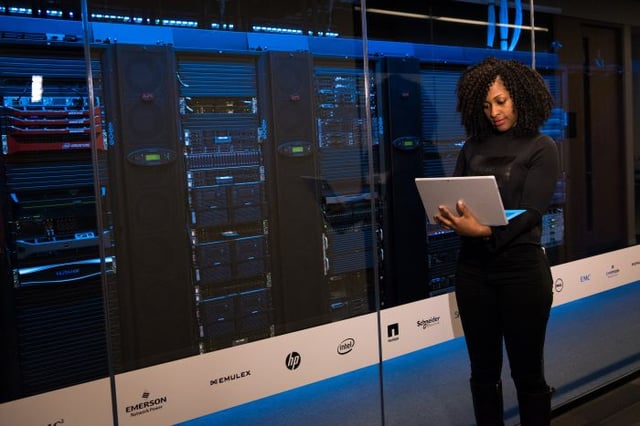The video game market is estimated to reach $92.5 billion globally by 20141, due, in part, to the velocity of social media and mobile device adoption. As a result, gaming companies are facing complex decisions as they try to build gaming infrastructures that can cost-effectively support this growth while delivering peak performance for players.
The success of an online game depends on a variety of variables, including the target audience and engagement strategy, device platform choice, game play and logic, and monetization and analytics capabilities, to name just a few. However, underlying all of these elements is the IT infrastructure that supports the entire online gaming stack. While a public (or virtualized) cloud may be ideal in some cases, bare-metal cloud servers, managed hosting, private cloud or colocation may be better suited for others. It depends on the type of application, whether it’s a massively multiplayer online game (MMOG), mobile, social, or casual game, as well as the use case, such as new game launches, trailer streaming, testing and development, or massive, on-demand scaling.
Online gaming is a progression of technological advances rather than a particular class of games, and it is important to consider these five key factors, identified by Internap, when building an online game infrastructure.
______________________________________________________________
[1] “The Video Gaming Industry Outlook 2011.” Business Insights. May 2011.

Click through for five key factors that must be considered when building an online game infrastructure, as identified by Internap.

New game titles are constantly emerging with game concepts for players to try. With the increase in the number of small game developers producing similar titles to reach the mobile app stores, the ability to release before the competition and gain adoption may determine the game’s long-term success.
Ways publishers are driving rapid adoption include:
- Free-to-play models combined with virtual goods marketplaces and/or other micro transaction strategies
- Launching games with fewer features (e.g., smaller worlds) and once the title has proven successful, new features and functionality are deployed through game expansions or downloadable content packs (DLCs) generating incremental revenue and extending the life of the game.
- Supporting a lower entry price point for the customer by employing on-demand computing and storage infrastructure to minimize costs.
- Public cloud and bare-metal cloud servers offer ideal solutions to studios looking to quickly spin up computing resources for development, testing, beta and launch cycles.

Since downtime equals lost revenue, low adoption and damage to reputation, game publishers aim to ensure a reliable game experience by building out their infrastructure with resiliency and high availability in mind.
Building for Resiliency:
- With a horizontal scaling approach, multiple low-cost servers that are functionally the same are set up to run together using global and local load balancers to route traffic. In the event that one server fails, another automatically picks up the load to prevent downtime. Diversifying these loads across VMs, physical servers, data centers and geographies provides more and more layers of protection against systematic, large-scale outages.
Building for High Availability:
- Games that are more “fault sensitive,” and that have lower latency requirements such as certain MMOG genres, are often deployed on custom hosting solutions like managed hosting, private cloud or colocation.
- Platforms are built using higher-end equipment and custom configurations that support faster access to storage and more failover options because they are designed to support the specific application.
- High-availability infrastructure and service-level guarantees are constructed for global IP routing and switching, back channel device networking, data center or rack-level power distribution, as well as the server and storage hardware itself.

Latency is one of the biggest areas of concern for online game companies because of its potential ongoing negative impact on subscriber churn and in-game transaction conversion rates. These issues can be divided into server-side and network-side components. Understanding where a game falls within the latency-sensitivity spectrum is a key component of infrastructure planning.
Infrastructure solutions used to minimize latency include:
Server-side:
- The use of bare-metal hardware
- High-speed network options like 10Gbps switching
- Customized servers with specialty elements like high I/O disks
Network-side:
- Overriding BGP routing decisions through multi-carrier optimization
- Using UDP and TCP acceleration techniques
- Leveraging edge caching for static file delivery, such as game patches

Publishers often experience a large influx of players when launching their triple-A title or a game developed by a large studio. The inability to deliver a quality gaming experience due to insufficient infrastructure can cause a lack of adoption and damage to reputation. Conversely, daily active users (DAUs) can dramatically decline when the curiosity factor subsides and “tourists” leave. In the past, simply overbuilding infrastructure by as much as 25 percent or more was the typical strategy when preparing for the initial launch spike. However, competition has since intensified and game adoption rates have become harder to predict. Just using infrastructure overbuild as a strategy has therefore become prohibitively expensive for some firms.
Alternative Solutions:
- On-demand services, like public cloud and bare-metal cloud services, can meet fluctuating demand because of their ability to be easily turned on or off with minimal ramp-up time.
- Hybrid environments are ideal for scalability and cost-effective for games with persistent worlds where thousands of players interact at the same time.

Different game architectures demand diverse infrastructure platforms, and requirements can change over time and differ by game function.
Infrastructure platform options include:
- Public Cloud – Because of its billing flexibility and speed to deployment, a public cloud is a popular choice for mobile, social and casual games. It can also be an ideal starting point for new game launches, testing and development as it also has a lower cost of entry and can rapidly scale with its on-demand, pay-as-you-go structure.
- Bare-Metal Cloud – Game genres, like first person shooters (FPS), that demand the same agility, automation and pay-as-you grow flexibility as public cloud but with the high performance and control of dedicated servers are increasingly considering bare- metal cloud environments.
- Custom Hosting/Colocation – Large, complex games with high persistence requirements and hundreds of servers supporting a single world are often better served by colocation or a customized hosting solution. Game and player statistics that are maintained across game instances and used for completive rankings are examples of use cases that are well suited to these infrastructure solutions.
- Private Cloud – A private cloud environment offers high levels of infrastructure customization and can help differentiate game performance while offsetting upfront costs compared to custom hosting or colocation.














